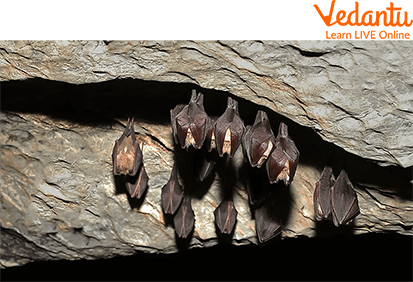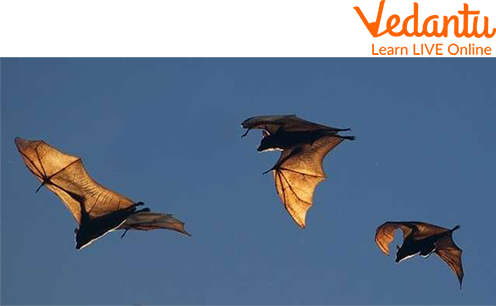




Overview of Bats
Our survival ability depends on forests, from the oxygen we inhale to the wood we use. Forests offer more than just habitat for animals and means of nutrition for people. They also help in protecting watersheds, prevent soil erosion, and lessen the effects of climate change. Bats are one such forest animal about whom we know very little.
The only set of mammals that can truly fly are bats. Bats can occasionally be mistaken for birds. However, bats are more closely linked to other mammals than to birds, including humans. Additionally, most bats lack feathers. In this article, we will learn about bats and their characteristics. We will also have some bat information for kids at the end of the article. Now, let’s dive in and gather more information about these creatures.
Who are Bats?
Although bats are mammals, they are the only mammal that can fly. Around 1,200 different species of bats, or nearly 5% of all mammal species, may be found worldwide.
The Kitti hog-nosed bat, one of the tiniest animals on the earth with an average length of 29–34 millimetres, is the smallest species of bat. The flying fox, which may reach a wing span of 1.7 metres, is the largest species of bat.
After the category of rodents, bats constitute the second-largest order of mammals. Megabats and microbats are the two main suborders into which they are frequently divided.
Learning About Bats
Habitat of Bats
The number of bat species, or kinds, is around 900. Worldwide, and particularly in the tropics, bats are common. They typically take a nap in caves, hollow trees, or attics. Some bats do nevertheless rest on rocks or trees.

Bats Habitat
Physical Qualities
Typically, the fur of bats is grey, tan, brown, or black. Depending on the species, they come in a wide range of sizes. When spread out, their wings can span anywhere from 6 inches (15 cm) to 5 feet (1.5 metres). They have huge, forward-facing ears that are typically pointed.
Thin layers of exposed skin make up the wings. They extend all the way from the long arms to the legs. The lengthy fingers are connected to one another by this thin skin.
Behaviour of Bats
The majority of bat species are social. The majority of bats sleep during the day. They sleep with their feet hanging upside down. Flying insects are what most bats eat. Some species consume fish, frogs, mice, birds, and other tiny creatures. Other species consume fruit, flower nectar, and pollen. The blood of huge birds and mammals is consumed by the vampire bats of South and Central America.
The majority of bats cry out while flying. This scream is too high pitched for anyone to hear. animals The sounds reverberate back to the bat after hitting surfaces. Based on the sounds that are reflected back, the bat can determine the size and distance of the objects. Bats use this knowledge to identify insects to eat as well as to stop flying into things in their path. The bat has the lightness and agility required for collecting insects, hovering above flowers, or swiftly avoiding obstacles because of the configuration of the wing membrane, the placement of the bones supporting it, and the placement of the muscles.

Flying Bats
Bat Facts for Kids
Let’s have a look at some interesting facts about bats for kids:
Worldwide, there are about 1,400 different species of bats.
Bats do not all hibernate.
Disease is one of the main hazards to bats because they have few natural predators.
Bananas, avocados, and mangoes will no longer be available without bats.
Bats pose the greatest threat to nighttime insects.
The only flying mammal is the bat.
Even though they are little, bats are quick little animals.
Conservation activities are helping in the recovery of bat species.
The 41-year-old bat is the oldest known.
Bats self-clean like cats do.
Not only dogs give birth to pups. Pups are the name for baby bats, while a colony is a collection of bats.
Medical miracles are being inspired by bats.
Outies or Innies? Bats have belly buttons besides humans.
Bats do not have feathers, instead they have a skin like membrane which looks like feathers.
Bats are the only flying mammal present on earth. Night insects have the most fear from these mammals.
Summary
Bats, any one of the 1,100+ species that make up the only group of mammals to have developed true flight. Their wings are an evolutionary development of the forelimbs, which are linked by a skin that runs down the side of the body and includes greatly expanded fingers. The majority of bats utilise sound waves to navigate and locate prey. They are widespread, although the tropics are where they are most prevalent.
This article was all about bats. We discussed their behaviour, facts and now we will be able to answer the questions about bats. We hope you enjoyed reading this article, in case of queries, feel free to ask in the comments.
FAQs on Facts About Bats for Kids
1. What are some interesting facts about bats for kids?
Bats are fascinating creatures with many unique qualities. Here are a few interesting facts about them:
Bats are the only mammals in the world capable of true, powered flight, unlike flying squirrels which can only glide.
There are over 1,400 species of bats, making up about 25% of all mammal species.
Many bats can live for over 20 years, which is a very long time for an animal of their size.
Baby bats are called pups, and they cling to their mothers while they fly.
2. What exactly is a bat?
A bat is a mammal, just like humans, dogs, and cats. This means they have fur, give birth to live babies, and feed their young with milk. The most special thing about bats is that they are the only mammals that can truly fly, using wings made of a thin layer of skin stretched over long finger bones.
3. How do bats find their food in complete darkness?
Bats use a remarkable ability called echolocation to navigate and hunt in the dark. They make high-pitched sounds that are too high for humans to hear. These sound waves bounce off objects like insects or trees, and the echo returns to the bat's ears. By listening to these echoes, a bat can create a mental map of its surroundings, allowing it to 'see' with sound.
4. Are bats really blind?
No, bats are not blind. This is a common myth. While most bats have small eyes and can see, they rely more on their incredible hearing and sense of smell to find their way. Their primary method for 'seeing' at night is echolocation, which is far more effective than eyesight in total darkness for catching tiny, fast-moving insects.
5. Why are bats so important for our planet?
Bats play a crucial role in keeping our ecosystems healthy. Many bats are excellent pollinators for plants like bananas, mangoes, and avocados. Others eat huge amounts of insects, including mosquitoes and pests that can harm crops, acting as a natural form of pest control. Their droppings, called guano, are also a very rich fertiliser.
6. Why do bats sleep hanging upside down?
Bats hang upside down for two main reasons. First, it's the perfect position for a quick getaway. Unlike birds, bats can't launch into flight from the ground. By hanging upside down, they can simply let go and fall into flight. Second, it keeps them safe from predators on the ground while they rest during the day in caves or trees.
7. What is the main difference between a bat's wing and a bird's wing?
The main difference is their structure. A bat's wing is actually a modified hand. It has a thumb and four long fingers, with a thin, flexible membrane of skin (called a patagium) stretched between them. A bird's wing is a more rigid limb covered in feathers, which create the surface for flight. Essentially, a bat flies with leathery hands, while a bird flies with feathered arms.
8. What do bats eat?
A bat's diet varies depending on the species. The vast majority of bats are insectivores, meaning they eat insects. Many others are frugivores, eating fruits and nectar from flowers. Only three species out of over 1,400 are vampire bats that drink blood, and they typically feed on cattle or other animals, not humans.





















